
Curly Grain Redwood
My first encounter with Curly Grain Redwood was at the Vine Hill Road site in Sebastopol in 1998. The guidelines for this extreme hippy palace were to use only reclaimed salvage and sinker log redwood for everything we were doing inside and out. I got to create many of the stunning exterior features and a good portion of the interior wainscoting and arches. Somebody else got to do the kitchen and the big bar/counter that divided it was a four inch by 24 inch by 8 feet long slab of curly redwood. It was going to be cut from a slab that was wider and longer and there was an L-shaped leftover piece that I was able make a deal for and take home. That's what I made Carol's mantle out of. Beautiful. Across the width of the original slab we counted 800 rings and from the looks of the vertical end grains the distance to the center of the tree must have been at least twice that.
Curly grain redwood comes about in two ways that I know about. The most common is a tree that was bent over while it was small and the curliness was the result the wrinkles, like the wrinkles in your skin when your wrist is bent over. The curly wood goes for a short way up the trunk to where it could grow straight up. You find partially curly boards among a stack of milled lengths of redwood dimension lumber. The effect will peter out before it gets to the end; beautiful though.
The other type is genetically curly. The curliness begins in the burl and extends all the way to the very top and to the tip of every branch and twig. Take a look at these photos of a chunk from a tree of that character. The curly is consistent through every cubic inch.



I know where this tree grew and how this piece of it, and many others, came into my possession.
The man who milled it was a transplanted Scotsman named Scott. For decades he occupied the large barn alongside the road in Nicasio Valley in bucolic West Marin County, a half mile from where he lived at the time. He made some of his living salvaging of driftwood logs and timbers off the beach, back when it was legal; and downed trees from wherever they might fall. He had a "boom truck", which was a makeshift crane with a cable winch. He was the go-to guy in West Marin when a fallen tree was blocking a roadway. He would arrive with a chainsaw and his boom truck, clear the way for traffic, and take what logs he could make use of up to the quarry where his milling machine was.
A "Woodmizer", is a portable lumber mill. It's built on a 20 foot long trailer. It has a bandsaw powered by what looked like a small car engine that rides on a track the length of the trailer, allowing the miller to slice any given thickness of wood off the top of a log loaded and clamped to the trailer bed. Once milled, he hauled the pieces down to the barn where they could dry and season for years.
Rancho Nicasio is at the center of the town. Besides a church and a baseball diamond, there's not much else there. Up the road a half mile there's a Cheese making operation next to Scott's barn. The Rancho includes the tiny local post office, an equally tiny store, and the bar and restaurant which features big time bay area music stars in the big dining room and in the summer, afternoon concerts on the lawn. Some of Scott's huge slab tables serve the outdoor buffet.
When he left for Scotland, probably for the last time, some of his friends including myself were tasked with first helping him clear out the barn, and after he was gone, disposing of his belongings from a house he had been occupying near Point Reyes Station. There were some more big unfinished tables, and every manner of unusual works of art, there was curly redwood tray to match one he had given me earlier, which I claimed, some unfinished wooden crosses, and a pair of unremarkable slabs of a species I haven't identified that I came away with.
It was pretty clear if you spent any time with Scott that he was a keen observer of nature and a friend to all critters. He was specially knowledgeable about trees. He liked to say he "never killed a tree." They were all dead and laying down when he met them.
About twenty years ago, an unusual redwood tree had come down during a storm up a mountainside in the Nicasio watershed. Scott was the one allowed to claim this treasure. It was 700 feet from the nearest road, it was huge, and it was genetically curly. He was able to chainsaw it into 16-foot segments and winch the logs all the way through the forest with cables.
When I met him, about 2007, he had already milled and sold off stock for a number of projects, including a whole room of curly paneling that must have been dazzling. I purchased a few choice pieces that I used to make my stereo cabinet, CD cabinets, shown below, and parts of the Ganesh altar.








In 2013, about five years later, he had an 18 inch by 2-foot block about 11 feet long sitting on his Woodmizer up at the quarry. I asked him to cut me a slab 4 inches thick. I had in mind that I would find an opportunity to make a mantle like the one in Carol's house. Speaking of which, all these curly pieces have been combined on the long wall in Carol's living room. I'm going to write a chapter about The Temple of Curly Redwood.
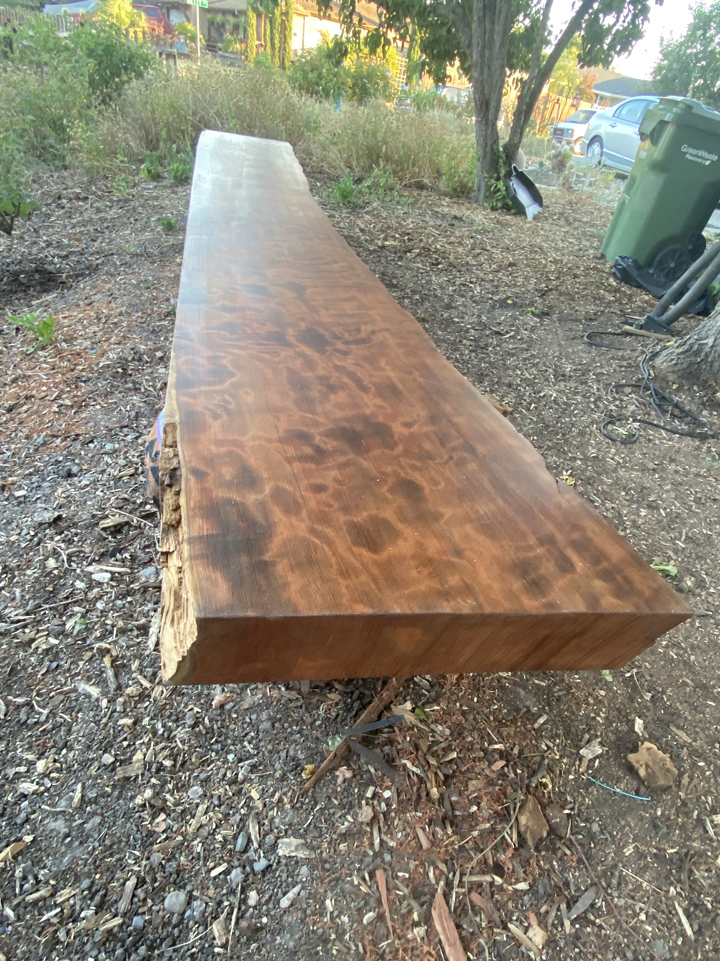
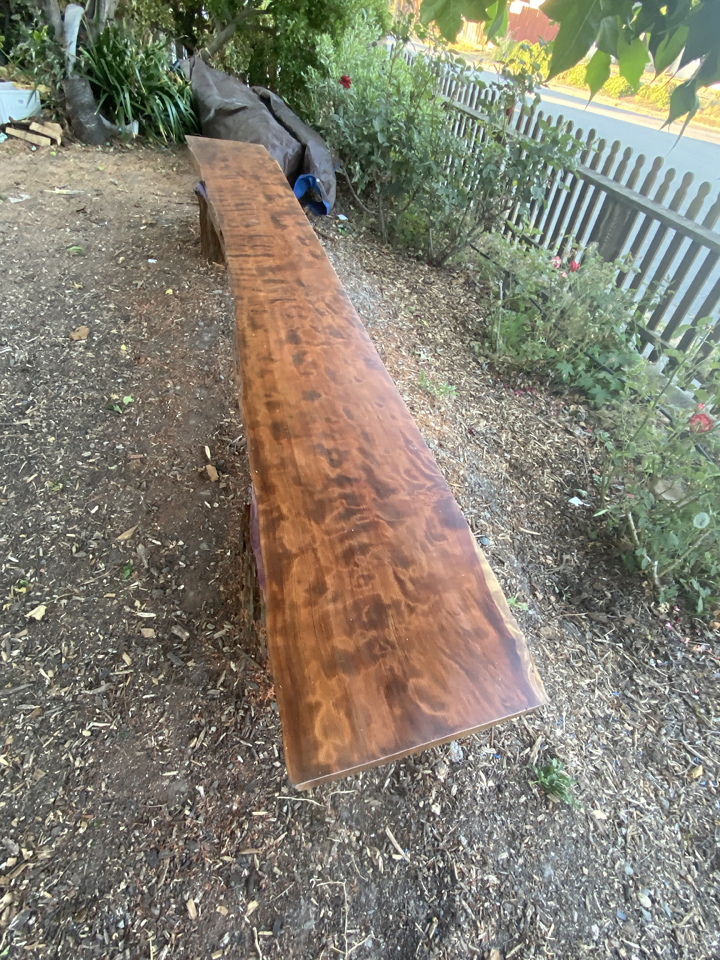
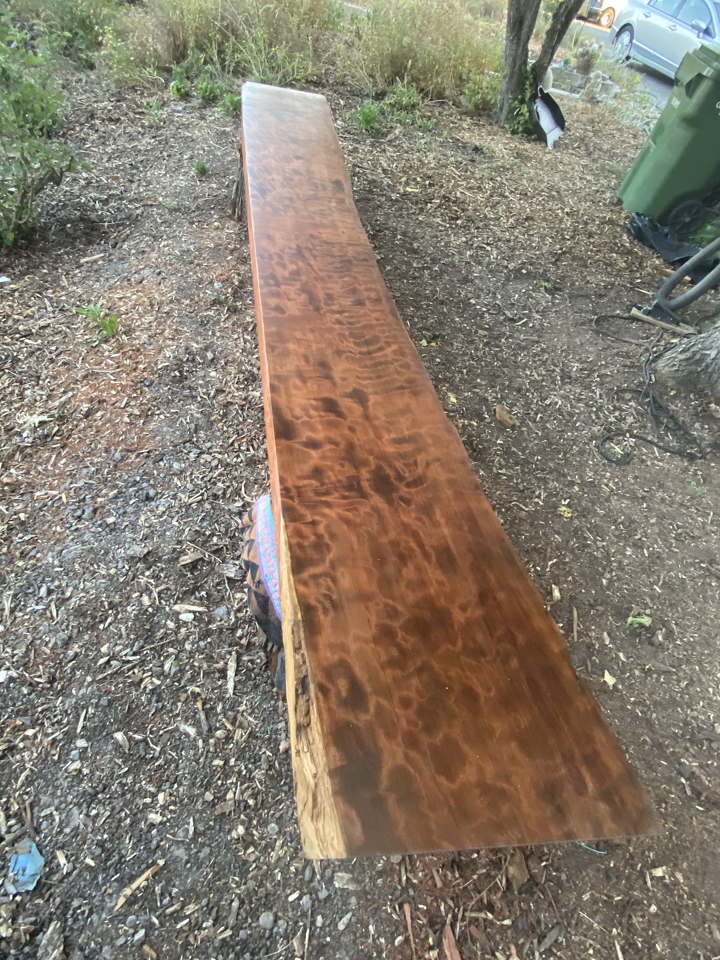
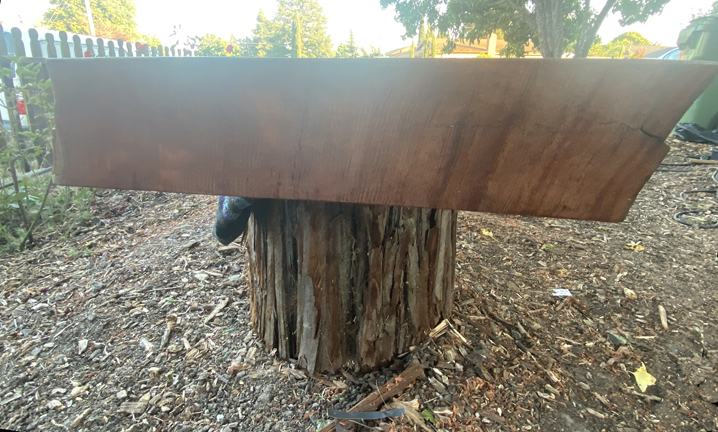
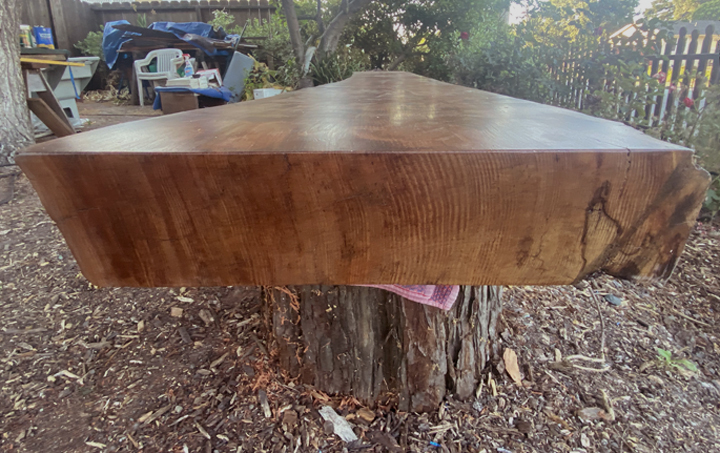
It's a mantle, a table, a bar, or a bench just like it is. I can't find anything online comparable to this curly grain rarity. The even second growth quality slabs seem to go for $15 per board foot. This is premium old growth and with its dazzling grain, it's a one of a kind piece of wood.
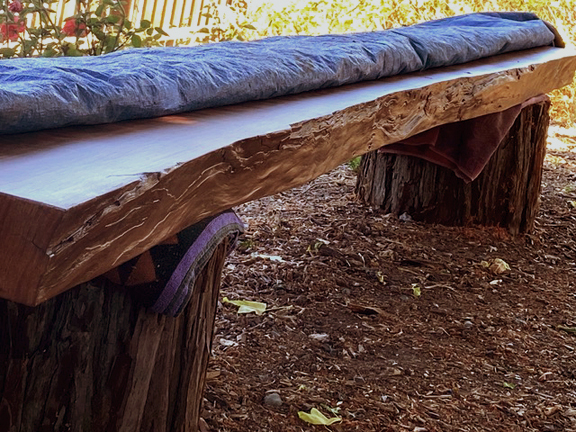
Well, it's 2024, and I'm still living here with Carol and I'm not going anywhere. I still have that slab, and I somewhat reluctantly am putting it up for sale. The finished slab you see below will undoubtedly become someone else's project. I wish them well and look forward to seeing what they do with it.
By my calculations, this is 10.2 feet x 1.2 feet x 4 inches thick, being 14+ inches at its narrowest. About 50 board feet, but with this unique piece, a board foot calculation is irrelevant.
Try to find a slab to compare this to. Knowing its benign sourcing, by a tree-hugging logger, its seasoning over 20 years, its rare and gorgeous figuring, I would regret selling it for less than $2000.
True to form, Scott went back to the spot where the curly tree went down and collected a sapling sprouted from the stump to ensure its genetics would continue. A few years ago, we went to the spot where he planted it above Cazadero. It was over 16 feet tall.
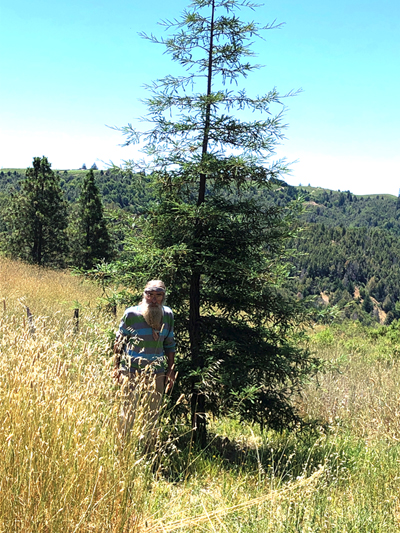
Uncle John's Garage Sale is just the name of the book.



Copyright © 2022, 2024 John Oliver
All Rights Reserved
mail@unclejohnsweb.com

My first encounter with Curly Grain Redwood was at the Vine Hill Road site in Sebastopol in 1998. The guidelines for this extreme hippy palace were to use only reclaimed salvage and sinker log redwood for everything we were doing inside and out. I got to create many of the stunning exterior features and a good portion of the interior wainscoting and arches. Somebody else got to do the kitchen and the big bar/counter that divided it was a four inch by 24 inch by 8 feet long slab of curly redwood. It was going to be cut from a slab that was wider and longer and there was an L-shaped leftover piece that I was able make a deal for and take home. That's what I made Carol's mantle out of. Beautiful. Across the width of the original slab we counted 800 rings and from the looks of the vertical end grains the distance to the center of the tree must have been at least twice that.
Curly grain redwood comes about in two ways that I know about. The most common is a tree that was bent over while it was small and the curliness was the result the wrinkles, like the wrinkles in your skin when your wrist is bent over. The curly wood goes for a short way up the trunk to where it could grow straight up. You find partially curly boards among a stack of milled lengths of redwood dimension lumber. The effect will peter out before it gets to the end; beautiful though.
The other type is genetically curly. The curliness begins in the burl and extends all the way to the very top and to the tip of every branch and twig. Take a look at these photos of a chunk from a tree of that character. The curly is consistent through every cubic inch.



The man who milled it was a transplanted Scotsman named Scott. For decades he occupied the large barn alongside the road in Nicasio Valley in bucolic West Marin County, a half mile from where he lived at the time. He made some of his living salvaging of driftwood logs and timbers off the beach, back when it was legal; and downed trees from wherever they might fall. He had a "boom truck", which was a makeshift crane with a cable winch. He was the go-to guy in West Marin when a fallen tree was blocking a roadway. He would arrive with a chainsaw and his boom truck, clear the way for traffic, and take what logs he could make use of up to the quarry where his milling machine was.
A "Woodmizer", is a portable lumber mill. It's built on a 20 foot long trailer. It has a bandsaw powered by what looked like a small car engine that rides on a track the length of the trailer, allowing the miller to slice any given thickness of wood off the top of a log loaded and clamped to the trailer bed. Once milled, he hauled the pieces down to the barn where they could dry and season for years.
Rancho Nicasio is at the center of the town. Besides a church and a baseball diamond, there's not much else there. Up the road a half mile there's a Cheese making operation next to Scott's barn. The Rancho includes the tiny local post office, an equally tiny store, and the bar and restaurant which features big time bay area music stars in the big dining room and in the summer, afternoon concerts on the lawn. Some of Scott's huge slab tables serve the outdoor buffet.
When he left for Scotland, probably for the last time, some of his friends including myself were tasked with first helping him clear out the barn, and after he was gone, disposing of his belongings from a house he had been occupying near Point Reyes Station. There were some more big unfinished tables, and every manner of unusual works of art, there was curly redwood tray to match one he had given me earlier, which I claimed, some unfinished wooden crosses, and a pair of unremarkable slabs of a species I haven't identified that I came away with.
It was pretty clear if you spent any time with Scott that he was a keen observer of nature and a friend to all critters. He was specially knowledgeable about trees. He liked to say he "never killed a tree." They were all dead and laying down when he met them.
About twenty years ago, an unusual redwood tree had come down during a storm up a mountainside in the Nicasio watershed. Scott was the one allowed to claim this treasure. It was 700 feet from the nearest road, it was huge, and it was genetically curly. He was able to chainsaw it into 16-foot segments and winch the logs all the way through the forest with cables.
When I met him, about 2007, he had already milled and sold off stock for a number of projects, including a whole room of curly paneling that must have been dazzling. I purchased a few choice pieces that I used to make my stereo cabinet, CD cabinets, shown below, and parts of the Ganesh altar.














By my calculations, this is 10.2 feet x 1.2 feet x 4 inches thick, being 14+ inches at its narrowest. About 50 board feet, but with this unique piece, a board foot calculation is irrelevant.
Try to find a slab to compare this to. Knowing its benign sourcing, by a tree-hugging logger, its seasoning over 20 years, its rare and gorgeous figuring, I would regret selling it for less than $2000.
True to form, Scott went back to the spot where the curly tree went down and collected a sapling sprouted from the stump to ensure its genetics would continue. A few years ago, we went to the spot where he planted it above Cazadero. It was over 16 feet tall.
